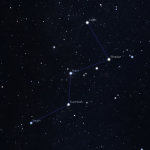| Meaning: | The Queen of Ethiopia, the Seated Queen | Print out the star map from Free Star Charts
Things to look for: Messier objects: Note: [x.x] indicates visual magnitude |
|
| Pronunciation: | kass ee oh pee’ uh | ||
| Associated Asterisms: | The W or the M. Part of the Three Guides | ||
| % of the sky: | 1.45% | ||
| Visible Stars: | 51 stars brighter than magnitude 5.5 |

Cassiopeia is circumpolar for observers in the UK and is approximately on the other side of the North Celestial Pole compared with Ursa Major. This is very useful as when trying to first orientate yourself in the night sky you tend to spot one or other first. Once you have one, you have the other as Alioth in Ursa Major and Navi in Cassiopeia are on straight line with Polaris in the middle; Navi is the central star of the familiar W and Alioth is the 3rd star in the handle of the Plough asterism.


The constellation is named the Queen of Ethiopia or the Seated Queen. It comprises 5 familiar stars although 9 have been named. The W is comprised, left to right, of Segin (ε Cas), Ruchbah/Ksora (δ Cas), Navi (γ Cas), Schedar/Shedar/Shedir (α Cas) and Caph (β Cas). Archird (η Cas) isn’t much dimmer than Segin but is omitted from the familiar asterism. It can be remembered as the Queen’s left elbow!


Cassiopeia contains several deep sky objects although only 2 were included in Messier’s catalogue. Both are Open Clusters i.e. collections/groups of stars within our Milky Way. The Open Cluster M52 is situated to the eastern boundary of the constellation and is sometimes referred to as the Salt and Pepper cluster. It is magnitude 6.9 so requires binoculars. To find it simply trace a line from Shedar to Caph and extend the same again on the other side. M103 is situated just a short hop from Navi and a quarter of the way to Segin. It is quite dim at 7.4 magnitude and interestingly other clusters in the constellation are brighter but didn’t make it to the catalogue.

